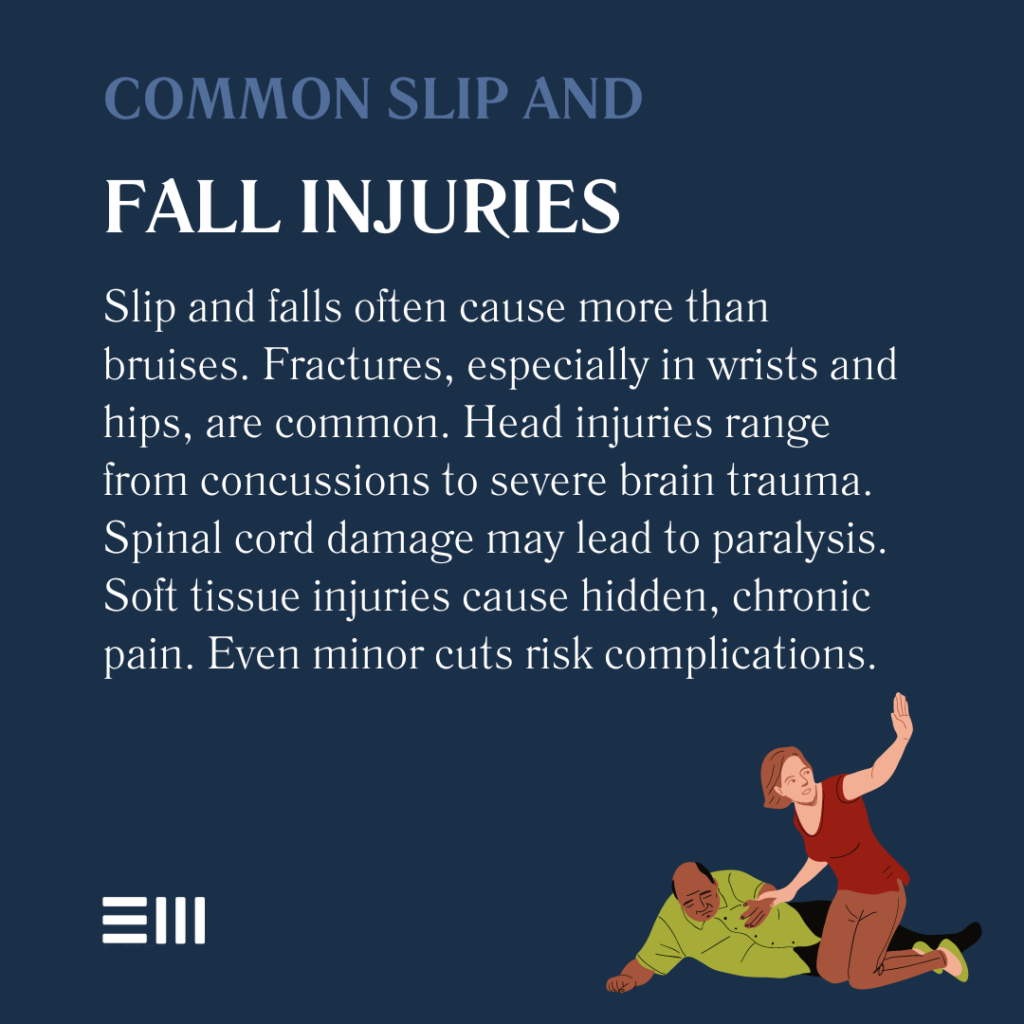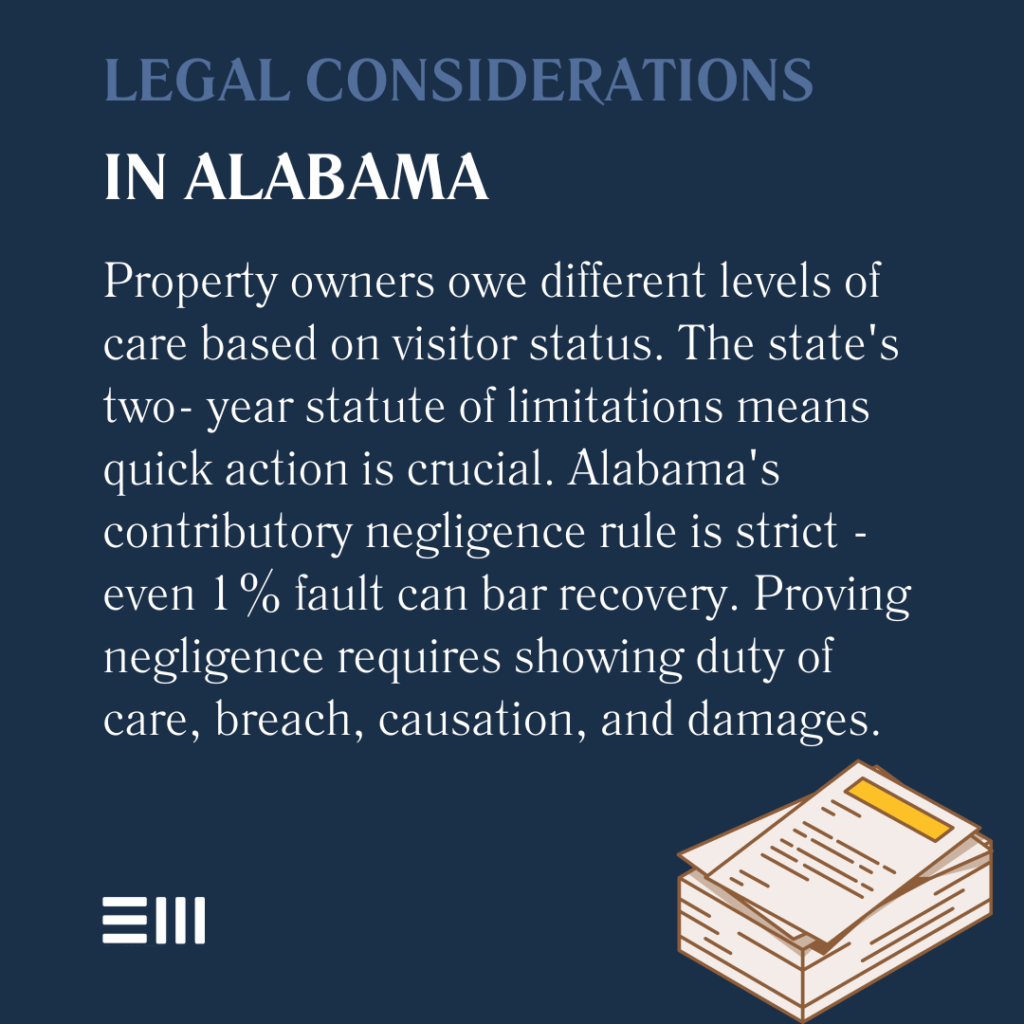
Every 11 seconds, an older adult is treated in the emergency room for a fall-related injury. This startling statistic from the National Council on Aging underscores the pervasive nature of slip-and-fall accidents.
But it’s not just the elderly at risk—these incidents can happen to anyone, anywhere, at any time.
Common Injuries in Slip and Fall Accidents
Slip-and-fall accidents can result in a wide range of injuries, varying from minor bruises to life-altering conditions.
Understanding these potential injuries is crucial for proper medical treatment and legal considerations.
Fractures and Broken Bones
Fractures are among the most frequent injuries in slip-and-fall accidents.
The sudden impact of a fall can easily lead to broken bones, particularly in vulnerable areas such as wrists, arms, hips, ankles, legs, ribs, and collarbones.
Head Injuries and Traumatic Brain Injury (TBI)
Head injuries are particularly concerning due to their potential long-term effects. A fall can result in concussions, contusions (bruising of the brain), or more severe traumatic brain injuries.
Symptoms may not always be immediately apparent, making it crucial to seek medical evaluation after any fall involving head impact.
Spinal Cord Injuries
Falls that impact the back or neck can lead to spinal cord injuries, which may result in partial or complete paralysis, loss of sensation, chronic pain, or impaired bodily functions.
The severity of spinal cord injuries can vary greatly, from temporary impairment to permanent disability, emphasizing the importance of proper diagnosis and treatment.
Soft Tissue Injuries
While often overlooked, soft tissue injuries can cause significant pain and impairment. These may include sprains, strains, torn ligaments or tendons, and muscle contusions.
Soft tissue injuries may not be immediately visible but can lead to chronic pain and reduced mobility if not properly treated.
Cuts, Bruises, and Abrasions
Surface injuries, while generally less severe, can still cause considerable discomfort and, in some cases, lead to complications such as infections.
These injuries may include lacerations requiring stitches, deep bruises (contusions), and skin abrasions or “road rash.” Proper cleaning and treatment of these injuries are essential to prevent infection and promote healing.
Understanding the range of potential injuries is crucial for both medical treatment and legal considerations in slip and fall cases. Each injury type may have different implications for recovery time, medical expenses, and long-term impact on the victim’s life.

The Recovery Process
The journey to recovery after a slip and fall accident can be complex and multifaceted. It often involves various stages and types of treatment, depending on the nature and severity of the injuries sustained.
- Immediate Medical Care: The first step in the recovery process is seeking immediate medical attention. This crucial phase involves emergency room visits for severe injuries, diagnostic tests (X-rays, MRIs, CT scans), and initial treatment plans.
- Ongoing Medical Treatment: Depending on the injuries, ongoing medical treatment may include follow-up appointments with specialists, physical therapy sessions, occupational therapy, medication management, and potential surgical interventions.
- Rehabilitation and Physical Therapy: Rehabilitation plays a vital role in recovery, especially for injuries affecting mobility. This phase may involve strengthening exercises, flexibility, and range of motion work, pain management techniques, and gait training and balance exercises.
- Pain Management: Managing pain effectively is often a key component of the recovery process. This may include prescribed pain medications, alternative pain relief methods (e.g., acupuncture, massage therapy), and psychological support for chronic pain management.
- Psychological Recovery: The emotional and psychological impact of a slip and fall accident should not be underestimated. Recovery may involve counseling or therapy sessions, support groups, and strategies for coping with anxiety or fear of falling.
Addressing all of these aspects is crucial for overall well-being and can significantly impact the physical healing process.
Legal Considerations in Alabama
Understanding the legal landscape surrounding slip-and-fall accidents in Alabama is crucial for victims seeking compensation and justice.
Alabama’s premises liability laws govern these cases, and several key factors come into play.
Alabama’s Premises Liability Laws
Alabama law requires property owners to maintain a reasonably safe environment for visitors.
However, the specifics can vary based on the visitor’s status:
- Invitees (e.g., customers in a store): Highest duty of care;
- Licensees (e.g., social guests): Moderate duty of care; and
- Trespassers: Limited duty of care, except for willful or wanton injury.
Understanding your status at the time of the accident is crucial in determining the property owner’s legal obligations.
Statute of Limitations
In Alabama, the statute of limitations for personal injury cases, including slip-and-fall accidents, is generally two years from the date of the incident.
This means victims have two years to file a lawsuit, and failing to file within this timeframe typically bars the right to seek compensation.
Contributory Negligence
Alabama follows a strict contributory negligence rule, which states that if the plaintiff is found even 1% at fault for the accident, they may be barred from recovering damages.
This makes it crucial to establish clear liability on the part of the property owner and underscores the importance of thorough evidence-gathering and strong legal representation in slip-and-fall cases.
Proving Negligence
To successfully pursue a slip-and-fall claim in Alabama, you generally need to prove:
- The property owner owed you a duty of care;
- They breached this duty through negligence;
- This breach directly caused your injuries; and
- You suffered damages as a result.
Gathering evidence such as photos, witness statements, and expert testimonies can be crucial in establishing these elements.

Frequently Asked Questions
Navigating the aftermath of a slip-and-fall accident can be overwhelming, but you’re not alone in your concerns.
Here are answers to some of the most common questions we encounter from Alabama residents dealing with these incidents.
How Long Does It Take to Recover From a Slip-and-Fall Injury?
Recovery time varies greatly depending on the nature and severity of injuries. Factors influencing recovery include the type of injury, age and overall health of the victim, adherence to treatment plans and rehabilitation, and complications during the healing process.
While minor injuries might heal in weeks, more severe injuries can require months or even years of recovery.
Can I Still File a Claim if the Accident Was Partly My Fault?
Alabama’s contributory negligence law makes it challenging to recover damages if you’re found even slightly at fault. However, determining fault is complex, and it’s worth discussing your case with an attorney.
They can evaluate the circumstances of your accident, assess the potential liability of all parties involved, and develop strategies to counter arguments of contributory negligence.
How Are Slip-and-Fall Settlements Calculated?
Settlements in slip and fall cases are calculated based on various factors, including medical expenses (current and future), lost wages and impact on earning capacity, pain and suffering, long-term effects of injuries, and the strength of evidence and liability arguments.
Each case is unique, and settlement amounts can vary widely.
Fight Harder, Fight Smarter
Have you or a loved one been injured in a slip-and-fall accident in Alabama? Don’t face this challenging time alone.
At Baxley Maniscalco, we understand the physical, emotional, and financial toll these accidents can take. Our experienced team of personal injury attorneys is ready to fight for your rights and help you secure the compensation you deserve.
Don’t let the statute of limitations or Alabama’s strict contributory negligence rule jeopardize your claim. Contact us today for a free, no-obligation consultation.
We’ll review your case, explain your options, and guide you through every step of the legal process.
Can't find what you're looking for? Search our site below.










